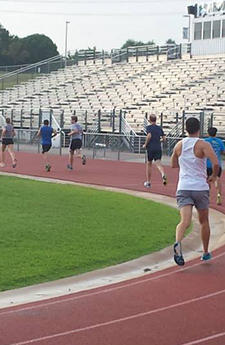Get On Track
The track is the White Castle of the running world. No one kinda likes White Castle. You either love it or you hate it.
It’s the same with track. Runners love it or hate it, but they are rarely indifferent. Some people love the idea of cranking out laps at breakneck speeds. Others would rather have a root canal.
I proposed to my wife on a track, so you can guess which side I’m on.
But whether you love the fiery cinders or hate them, the track is an excellent place to take your running to new heights.
Why hit the track?
Every training plan worth its weight in PR's has several different training components: a long duration, low intensity run; a medium duration, medium, intensity run; and a short duration, high intensity run.  The track provides an ideal location to customize a short duration, high intensity workout to your specific needs.
The track provides an ideal location to customize a short duration, high intensity workout to your specific needs.
Many a race has been sabotaged because we just didn't have a good feel for different speeds. The ability to recognize the rhythm of different race paces helps prepare us for the race at hand. Hitting the higher end of intensity levels also helps improve our race day performance by strengthening our hearts and improving stroke volume.
Another positive is that speedwork helps the body buffer lactic acid. When we push ourselves in a race, we often go anaerobic and produce a fun little byproduct called lactic acid. Lactic acid, along with a free hydrogen ion that's also produced, develops that burning muscle sensation we know all too well. By training our bodies to adapt to that byproduct, we can “callous” our bodies to its effects.
Speedwork also helps improve glute activation. Better glute activation allows us to improve both stride length and cadence, which of course, is where speed comes from in the first place.
Lastly, HIIT (High Intensity Interval Training) workouts are an ideal way to improve our bodies’ ability to burn more calories by cranking up our metabolisms, even several hours after the workout is over.
Speed Rules
Many people hate the track because they don't follow a few simple rules that would allow them to see speedwork success. If you hit the track without a proper understanding of how to hit the track, or if you have unrealistic goals and expectations of what the track is for, a track workout can turn into a factory of self-defeat. Following a few simple tried-and-true track rules can help ensure your speedwork session is a successful one.
Warm Up
Make sure you jog 10-15 minutes at an easy pace before you try to go fast. Your body needs time to warm up properly. Trying to go fast the moment you step out of your car is a recipe for failure. Follow your jog with some dynamic flexibility exercises. This will help loosen up tight muscles. Static stretching before a workout is an old wives’ tale. I’ve watched the Kentucky Derby for years, and I've yet to see a horse sit down to do a hurdle stretch before it heads to the gate.
Ease Into It
If you’re going to make a mistake, make the mistake of running a little too slow at the beginning. It's better to gradually build into your speed than blow the top off early and crash because of it. Easing into the workout will allow for a greater volume of solid quality and will also help you get a better feel for different intensity levels. Going too fast will cause you to dive into oxygen debt. Once that happens, you have to slow down, and you’ve learned nothing about pace except what too fast feels like.
Obey the Speed Limit
This doesn't mean you can't go faster than your goal pace. The track is a great opportunity to test our limits (gradually). When we talk about limits, we are talking about our own personal speed limits. The track is not about running at maximum effort from the gun. It's about being at the optimal intensity needed to train for our goals. If you’ve never broken 90 seconds in a 400, trying to run an 80-second 400 is counterproductive. Shoot for an 88 first. Then an 86. And so on.
Library Time
The track is not about social time (at least, while you’re running). The track is where we put on our work boots and get to work. Just like a library, there's not a lot of talking at the track. Even though we build into the workout, it's supposed to be hard. This is not the time to catch up on the week's events. This is the time to push each other to the uncomfortable places that are hard to reach when you’re running alone.
Stop the Music
Leave the headphones at home. Things move and happen quickly at the track. We need to be able to hear what's going on around us. We need to be able to focus. It’s great to be a part of the group, but only if you’re paying attention. No one wants a pileup.
Left Lane is the Fast Lane
Lane one is for going fast. That doesn't mean it's for the fastest people. It simply means that the inside lanes are for people who are running for time. That means warm-ups, cool downs, and rest periods need to be done in the outside lanes. This organization allows everyone to safely hit the gas at the track without wrecking.
Cool Down
Even when the workout is done, the workout is not over. After intense running, you need to help your body come back to earth. Hopping in the car and driving home after your last repeat is what keeps many chiropractors and orthopedics in business. Make sure you get in another 5-15 minutes of easy jogging or walking after the hard part of your workout is over. This is also the time to do some light static stretching. Flexibility gains are made after the workout.
Track-tionary
The track has a language of its own. Here are a few common terms that are often thrown around, but not always correctly.
Repeats: This is the running portion of the workout. For instance, if someone says they have 400's today, it means they're repeatedly running 400 meters. The 400 is the repeat. For example 10x400 means 10 repeats of 400 meters.
Intervals: This may be the most commonly misused term at the track. Many times people refer to repeats as intervals. In actuality, intervals are the interval of time between each repeat. Intervals are your rest periods. In the 10x400 repeats example, the workout might say to run the repeats with a 3-minute interval—or rest period—between the 400s.
Recovery: This is what you do during your interval. Sometimes the recovery will be a jog. Sometimes the recovery will be a walk. Sometimes your recovery will be simply to remain conscious. (Just kidding.) Take that 10x400 workout with a 3-minute jog interval. You now know the distance of the repeats, the number of repeats, the time between repeats, and what type of rest (recovery) you’re doing during that interval.
Split: This is how fast you’re supposed to run the repeats. If the workout is more than one lap, the split could be listed for each lap or for overall time. For instance, if you were running 800 repeats, the split might be 90 seconds per lap or say 3 minutes per 800. Either way, the track means math. You might want to brush up on your base-60 math skills.
Distances: Most tracks are 400 meters around. That means one lap is 400 meters, or a quarter of a mile, or about .25 miles. Four laps in lane one is 1600 meters, which is right at one mile (1609 meters).
Incorporating speedwork at the track into your training program is a great way to improve your fitness and drop some nice PR's. Finding a fun-loving group of people who are looking for the same thing is a cherry on top of the training and can really help you develop as an athlete. Fleet Feet's Summer Speedwork sessions kick off next week. We offer three different days and locations for your convenience. Come find out just how great hitting the track can be.
Good Luck and Happy Racing!
Coach Cary
 Tim Cary is FLEET FEET's Assistant Training Manager, coach of the FLEET FEET-sponsored Runnababez Elite team, and manager of the FLEET FEET Racing Team. Over his 20 years of coaching, Tim has coached athletes to three national team championships, five national individual championships, two national records, and numerous All-American and All-State honors. Click here to receive Tim's weekly article via email.
Tim Cary is FLEET FEET's Assistant Training Manager, coach of the FLEET FEET-sponsored Runnababez Elite team, and manager of the FLEET FEET Racing Team. Over his 20 years of coaching, Tim has coached athletes to three national team championships, five national individual championships, two national records, and numerous All-American and All-State honors. Click here to receive Tim's weekly article via email.
Connect With Us
see the latest from Fleet Feet St. Louis